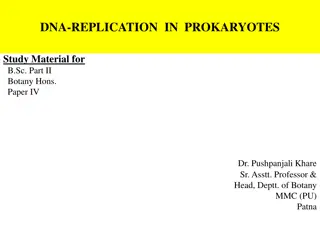Understanding DNA Structure, Replication, and Proofreading
Exploring the intricate world of DNA, this module delves into the structure of DNA, highlighting nucleotides, nitrogenous bases, and the double helix. It emphasizes how DNA stores genetic information in genes and undergoes replication through a semi-conservative model. The process of DNA replication, catalyzed by enzymes like DNA polymerase and helicase, is crucial for copying genetic information accurately. Additionally, the proofreading mechanisms in DNA maintenance, involving enzymes like exonucleases and nucleotide excision repair, ensure the fidelity of DNA sequences.
Download Presentation

Please find below an Image/Link to download the presentation.
The content on the website is provided AS IS for your information and personal use only. It may not be sold, licensed, or shared on other websites without obtaining consent from the author. Download presentation by click this link. If you encounter any issues during the download, it is possible that the publisher has removed the file from their server.
E N D
Presentation Transcript
Biology I for Non-Majors Module 8: DNA Structure and Replication
DNA The building blocks of DNA are nucleotides Nitrogenous base Deoxyribose (5-carbon sugar) Phosphate group The nitrogenous base can be a purine, such as adenine (A) and guanine (G), or a pyrimidine, such as cytosine (C) and thymine (T)
DNA Stores Genetic Information The genetic information of an organism is stored in DNA molecules The information stored in the order of bases is organized into genes Each gene contains information for making a functional product In order for DNA to function effectively at storing information, two key processes are required Information stored in the DNA molecule must be copied, with minimal errors, every time a cell divides The information stored in the DNA molecule must be translated, or expressed Both copying and reading the information stored in DNA relies on base pairing between two nucleic acid polymer strands
DNA Replication Meselson and Stahl determined DNA replicates by a semi-conservative model Each of the two parental DNA strands act as a template for new DNA to be synthesized After replication, each double-stranded DNA includes one parental or old strand and one new strand
DNA Replication Enzymes DNA replication is catalyzed by DNA polymerase An enzyme that attaches many pieces of DNA DNA polymerase needs an anchor to start adding nucleotides A primer is a short sequence of DNA or RNA that is complementary to the template strand will work to provide a free 3 end A helicase helps unwind and separate the DNA helices
Proofreading DNA In proofreading, the DNA pol reads the newly added base before adding the next one, so a correction can be made If an incorrect base has been added, the enzyme makes a cut at the phosphodiester bond and releases the wrong nucleotide Performed by the exonuclease action of DNA pol III Mismatch repair are corrections that occur after replication is completed Enzymes recognize the incorrectly added nucleotide and excise it; this is then replaced by the correct base In nucleotide excision repair, enzymes replace incorrect bases by making a cut on both the 3 and 5 ends of the incorrect base
Viruses Viruses are acellular, meaning they are biological entities that do not have a cellular structure Sometimes called virions: complete virus free in the environment Consists of at least a nucleic acid core and an outer protein coating or capsid Sometimes a virus will have an outer envelope made of protein and phospholipid membranes derived from the host cell
Viral Life Cycles Lytic cycle The phage replicates and lyses the host cell Lysogenic cycle Phage DNA is incorporated into the host genome, where it is passed on to subsequent generations Called a prophage while in the host genome
Types of Viral Infections Acute disease Symptoms get increasingly worse for a short period followed by the elimination of the virus from the body by the immune system and eventual recovery from the infection Chronic Infections Long-term Intermittent symptoms Only occasionally present Asymptomatic infection No symptoms are present in the host
Plant Viral Infections Horizontal transmission Between different plants Vertical transmission From parent to child Table 1. Some Common Symptoms of Plant Viral Diseases Symptom Appears as Hyperplasia Galls (tumors) Hypoplasia Thinned, yellow splotches on leaves Cell necrosis Dead, blackened stems, leaves, or fruit Abnormal growth patterns Malformed stems, leaves, or fruit Discoloration Yellow, red, or black lines, or rings in stems, leaves, or fruit
Prions and Viroids Prions Proteinaceous infectious particles No nucleic acids Cause fatal neurodegenerative diseases Kuru Mad cow disease Viroids Plant pathogens Small, single-stranded circular RNA particles Make no proteins Infect plants
Quick Review Draw the basic structure of DNA How does the structure of DNA relate its function in storing genetic information? List the basic steps in DNA replication What are the key enzymes in DNA replication and their functions? How is DNA proofread? Draw the basic structure of a virus What are the two main types of viral infections? Describe a prion What are viroids and what do they target?























